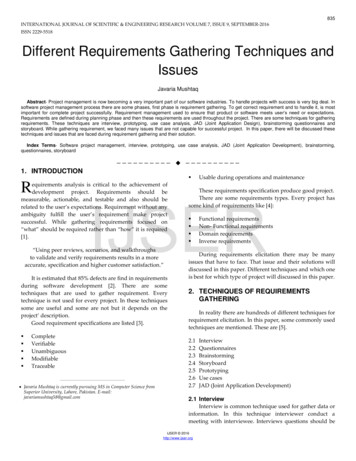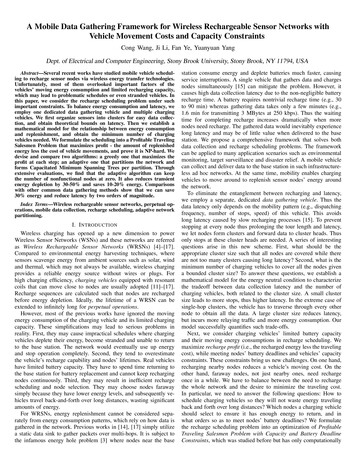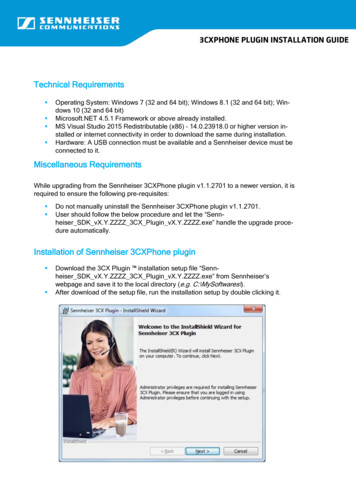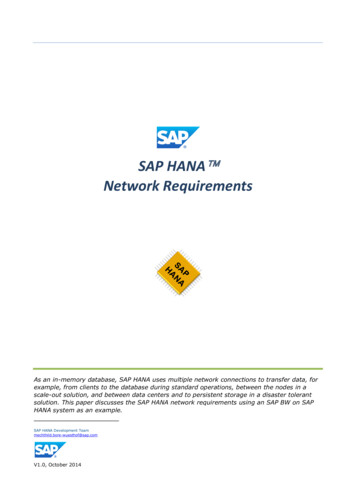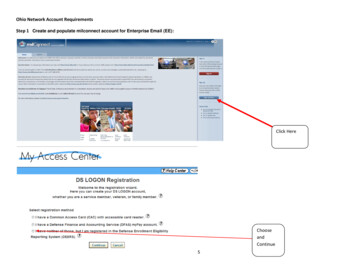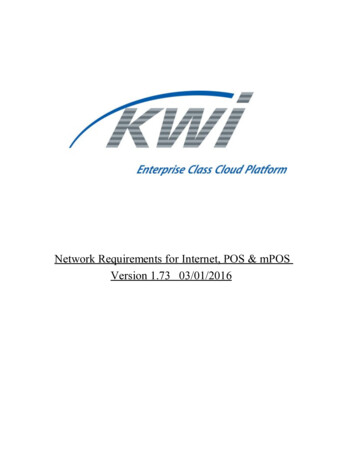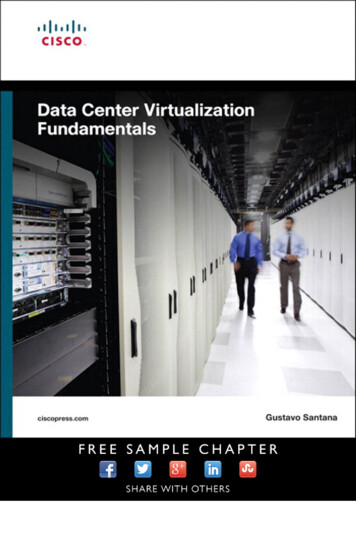
Transcription
CHAPTER 2Gathering Network RequirementsObjectivesUpon completion of this chapter, you should be able to answer the following questions: What occurs during the six phases of thePPDIOO model? What is the proper way to respond to a Requestfor Proposal or Request for Quote? How are business goals prioritized to determinetechnical requirements for a network upgradeproject? How do constraints affect the design of a network?What are the roles of a network partner team?Key TermsThis chapter uses the following key terms. You can find the definitions in the Glossary.business caseavailabilitypage 50page 51Request For Proposal (RFP)Request For Quote (RFQ)page 53page 53reliability page 51system-level acceptance testing page 55securitynetwork baselinepage 51scalabilitypage 51manageabilityPPDIOOpage 51page 51page 56Network Management System (NMS)page 70Simple Network Management Protocol version 3(SNMPv3) page 70Management Information Base (MIB)page 72
50Designing and Supporting Computer Networks, CCNA Discovery Learning GuideIn this chapter you are introduced to StadiumCompany, a sports facility management company thatmanages a stadium located outside of a major city. StadiumCompany needs to upgrade its existingcomputer network to provide state-of-the-art services. To do this, StadiumCompany management outlinesa three-phase project. In the first phase, StadiumCompany is contracting with NetworkingCompany, alocal Cisco business partner, to prepare a network design requirements document. In the second phase,the stadium management plans to issue a contract for the detail network design. After the design iscompleted, the final phase will be the installation and implementation of the network upgrade.StadiumCompany is also in the process of negotiating a contract with FilmCompany, a film productioncompany located in the nearby major city. FilmCompany will be responsible for producing, filming,and delivering high-quality video for download from the stadium website. StadiumCompany managementis also requiring FilmCompany to produce live video displays during the sporting events and concertsheld at the stadium.Follow the progress of NetworkingCompany as it helps both StadiumCompany and FilmCompanyplan and design their network upgrades.The StadiumCompany story demonstrates concepts in the main text, media, and PacketTracer (PT)activities. The FilmCompany story provides context for the corresponding student practice in thehands-on labs.As you job-shadow the NetworkingCompany team, you will learn the skills needed to plan anddesign the StadiumCompany network upgrades. Your new design skills enable you to support theNetworkingCompany team plan and design similar upgrades for the smaller FilmCompany network.The design portfolio you create during this work assignment will enable you to develop and presentyour network upgrade proposal to the FilmCompany management team.In general, the StadiumCompany design project is used in the main text, media, and PT activities.The FilmCompany design project is completed in the hands-on labs. The StadiumCompany story (seeAppendix B) and the FilmCompany story (see Appendix C) are located in the appendixes and on theaccompanying CD-ROM.Introducing Cisco Lifecycle ServicesThe world of networking is evolving. Networking is no longer just about connecting computers. Networkinghas become intelligent and plays a vital role in helping to improve business performance. Businessesare eager to expand their networks. Taking advantage of advances in technology, companies can addnew services and increase productivity.Cisco Lifecycle Services is designed to support evolving networks. Cisco Lifecycle Services is a six-phaseapproach. Each phase defines the activities required to successfully deploy and operate Cisco technologies.It also details how to optimize performance throughout the lifecycle of a network.The six phases of the Cisco Lifecycle Services are as follows: The Prepare phase: The Prepare phase involves establishing the organizational requirements,developing a network strategy, and proposing a high-level conceptual architecture identifyingtechnologies that can best support the architecture. The Prepare phase can establish a financialjustification for network strategy by assessing the business case for the proposed architecture.The Plan phase: The Plan phase involves identifying initial network requirements based ongoals, facilities, user needs, and so on. This phase involves characterizing sites and assessing anyexisting networks. It also includes performing a gap analysis to determine whether the existingsystem infrastructure, sites, and operational environment are able to support the proposed system.
Chapter 2: Gathering Network Requirements51A project plan is useful to help manage the tasks, responsibilities, critical milestones, andresources required to implement changes to the network. The project plan should align with thescope, cost, and resource parameters established in the original business requirements. The Design phase: The initial requirements that were derived in the Plan phase drive the activitiesof the network design specialists. The network design specification is a comprehensive, detaileddesign that meets current business and technical requirements. It incorporates specifications tosupport availability, reliability, security, scalability, and manageability. The design specificationis the basis for the implementation activities.The Implement phase: After the design has been approved, implementation (and verification)begins. The network is built, or additional components are incorporated, according to the designspecifications. The goal is to integrate devices without disrupting the existing network or creatingpoints of vulnerability.The Operate phase: Operation is the final test of the appropriateness of the design. The Operatephase involves maintaining network health through day-to-day operations, including maintaininghigh availability and reducing expenses. The fault detection, correction, and performance monitoringthat occur in daily operations provide initial data for the Optimize phase.The Optimize phase: The Optimize phase involves proactive management of the network. Thegoal of proactive management is to identify and resolve issues before they affect the organization.Reactive fault detection and correction (troubleshooting) is needed when proactive managementcannot predict and mitigate failures. In the PPDIOO process, the Optimize phase may prompt arecommendation for network redesign. Redesign may be necessary if too many network problemsand errors arise, if performance does not meet expectations, or if new applications are identifiedto support organizational and technical requirements.This process is often referred to as PPDIOO, based on the first letters of each of the six phases.Case Study: Sports Stadium NetworkThe management organization of a stadium is working with the NetworkingCompany to renovate andupdate the stadium network. Over the years, the stadium network has grown. However, little thoughtwas given to overall business goals and infrastructure design. Some new projects went forward. Butthe network administrators did not have a realistic understanding of the bandwidth, traffic prioritization, and other requirements needed to support such an advanced and business-critical network. Thestadium management now wants to add new high-tech features, but the existing network is not capableof supporting them.NetworkingCompany representatives meet with the stadium management to discuss the process theyintend to use to design the new network. Although the Design phase is only one of the phases in thenetwork lifecycle, all of the PPDIOO phases impact the design decisions.In the Prepare and Plan phases, the network designer and stadium staff identify the business goals andtechnical requirements of the stadium organization as well as any design constraints. The requirementsgathering that occurs during these phases influences the decisions made during the Design phase.The Implement phase begins after the approval of the design. It includes the initial integration of thenew design into the existing network.During the Operate and Optimize phases, the stadium personnel analyze and monitor the networkperformance.
52Designing and Supporting Computer Networks, CCNA Discovery Learning GuideThe Network Lifecycle Prepare PhaseDuring the Prepare phase, the stadium management and NetworkingCompany staff define the followingbusiness goals: Improve customer experience Reduce costs Add additional services Support company expansionThese goals provide a foundation for a business case. The business case is used to justify the financialinvestment required to implement the technology change. The company considers possible businessconstraints, including budget, personnel, company policies, and schedule limitations.The five business case components are as follows:1. Purpose of the Project How the project meets company business goals Main benefits and risks Success measurements2. Cost/Benefit Analysis Options to meet business goals Nonfinancial benefits3. Sourcing Options Sources required for services (outside vendors, network installation companies) Purchasing procedures4. Budgeting Affordability and funding sources (internal and external) for whole project at once or over aperiod of time5. Project Management Project plan and roles Timeline Major risks and plan to minimize impact Emergency plans if project not accomplished Skills and personnel requirementsAfter the business case is accepted, the NetworkingCompany staff assists in the development of thehigh-level technology strategy and solution.This strategy identifies the following: Advanced technologies that support the new network solution Current and planned network applications and services, and their priorities based on business goals People, processes, and tools required to support the operations and management of the technologysolution
Chapter 2: Gathering Network Requirements53The Prepare phase is typically done before a company issues a Request For Proposal (RFP) orRequest For Quote (RFQ). RFPs and RFQs describe the requirements for the new network. Theyinclude information about the process that the company uses to purchase and install networkingtechnologies.The Network Lifecycle Plan PhaseDuring the Plan phase, the network designer performs a comprehensive site and operations assessment.This assessment evaluates the current network, operations, and network management infrastructure.The NetworkingCompany staff identifies all physical, environmental, and electrical modifications. Theyassess the ability of the current operations and network management infrastructure to support the newtechnology solution. All changes to infrastructure, personnel, processes, and tools must be completedbefore the implementation of the new technology solution. Sample assessment areas are as follows: Environmental Potential electrical issues Space issues in racks/wiring closets UPS or backup power issues AC issues with additional equipment Adequate cabling infrastructurePersonnel Adequate number of staff for maintaining planned upgrade Technical knowledge level of staff adequate or staff needs trainingCustom applications that add to the feature and functionality requirements for the new network arealso identified in this phase. The NetworkingCompany staff creates a document that contains all of thedesign requirements.The Project PlanIn this phase, the NetworkingCompany staff and stadium management create a plan to help managethe project. The project plan includes the following: Tasks Timelines and critical milestones Risks and constraints Responsibilities Resources requiredThe plan needs to be within the scope, cost, and resource limits established in the original business goals.Both the stadium management and the NetworkingCompany assign individuals to manage the project.Lab 2-1: Creating a Project Plan (2.1.3)In this lab, you will identify the business goals and constraints for the FilmCompany. Refer to thehands-on lab in Part II of this Learning Guide. You may perform this lab now or wait until the end ofthe chapter.
54Designing and Supporting Computer Networks, CCNA Discovery Learning GuideThe Network Lifecycle Design PhaseIn the Design phase, the NetworkingCompany staff uses the initial requirements determined during thePlan phase to direct its work. Figure 2-1 shows the initial topology identified during the Plan phase.Figure 2-1Physical ConnectionsPhysical ConnectionsISP2Ticket SalesOfficeInternetVPN(Over DSL)VPN(Over DSL)ISP3Vendor(Souvenir Shop)ISP1Edge RouterStadiumSwitchDNS WebTeamSwitchVendorSwitchAccountingLuxury SuitesSwitchAccountingE-CommerceAccountingStadium LANPayrollTeam Services LANVendor Services LANVIP Services LANThe design requirements document supports the specifications identified in the Prepare and Planphases for the following: Availability Scalability Security ManageabilityThe design must be flexible enough to allow for changes or additions as new goals or needs emerge.The technology must be integrated into the current operations and network management infrastructure.
Chapter 2: Gathering Network Requirements55Planning the InstallationAt the end of the Design phase, the network designer creates plans that guide the installation andensure that the end result is what the customer requested. Plans include the following: Configuring and testing connectivity Implementing the proposed system Demonstrating the functionality of the network Migrating network applications Validating network operation Training end users and support personnelDuring the Design phase of the stadium network upgrade, the design of the network is completed. Anynew equipment and technologies are specified and tested. A review of the proposed design confirmsthat the business goals are met. A final proposal is generated to continue with the implementation ofthe network
your network upgrade proposal to the FilmCompany management team. In general, the StadiumCompany design project is used in the main text, media, and PT activities. The FilmCompany design project is completed in the hands-on labs. The StadiumCompany story (see Appendix B) and the FilmCompany story (see Appendix C) are located in the appendixes and on the accompanying CD-ROM.File Size: 2MBPage Count: 30
